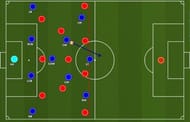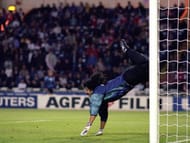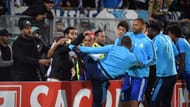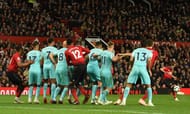In this article, we are going to see football rules that even the most ardent fans don’t know about. These are not something that you usually see in regular games. No matter how knowledgeable you are about football, there are always a bunch of unusual, obscure rules that you haven’t come across.
So, unless you are a football referee you can be forgiven if you haven’t heard about some or all of these rules. Here are 10 such rules that you probably haven't heard of.
#10 No offside rule during corner kicks, throw ins and goal kicks
There is no offside offence if a player receives the ball directly from:
- a goal kick
- a throw-in
- a corner kick
First one is a pretty straight-forward one and needs no lengthy explanation. But, the new rules state that opponent players cannot be present inside the penalty box during a goal kick, and this can be used by the attacking team to beat the opponent press and gain an advantage. It is explained in one of my previous articles here.
#9 Minimum 7 players for a team on the pitch
There must be a minimum of seven players in a team on the pitch for a match to start or continue. This means a maximum of four red cards can be given to on-field players of a team in a single match. A fifth one would stop the match, as one team wouldn’t have the required number of players on the pitch for the match to proceed.
#8 Equal number of players during a penalty shoot-out

During penalty shoot-outs, an equal number of players must be available in both teams to take the penalties. That is if a match between Team A vs Team B ends in a draw and moves to penalties, and a player from Team A got sent off already during the match, then only 10 players from Team B can be available for the shoot-out.
This happened at one of the biggest matches in world football: 2006 FIFA World Cup Final. That’s right. That match is infamous for one thing, Zinedine Zidane head-butting Italy’s Marco Materazzi.
For the uninitiated, Materazzi, the Italian central defender (who would go on to become the player-manager of Chennaiyin FC) abused Zidane which got him a head-butt right in the center of his chest. Obviously, Zidane got sent off and the match entered the penalty shoot-out stage.
As France had only ten players, Italy had to exclude one of their own from the shoot-out and Gennaro Gattuso, who finished the entire 120 minutes, was the one to sit out.
#7 You cannot be offside in your own half

Why is there an offside rule? It is there to prevent the attacking team from parking on of its players near the opponent goal. If there was no offside rule, we might very well call this sport 'Airball' instead of football because there would be no defense-splitting through balls, perfect crosses and timed runs. Now, where would be the fun in that?
If a player receives the ball in his own half and he is in an offside position when the pass was made, it essentially means that the team in its own half has not kept one of its players waiting near the opponent goal. So, in this case not calling offside, even though the player receiving the ball is nearer to the goal than the ball and second-last defender, would not defeat the purpose the offside rule was made for.
Of course, this only holds when the player receiving the pass has not crossed the halfway line when the pass is actually made.
#6 Goalkeepers may wear tracksuit bottoms but not others

This is also straight-forward and needs no explanation. And to be frank, I wouldn’t fault you if you think it would look ridiculous if a single player on the pitch wears a tracksuit while the others are in shorts because I share your thought.
And when you talk about goalkeepers wearing tracksuit bottoms, you cannot leave out René Higuita, the former goalkeeper of the Columbian nation team, also known as El Loco. He is mainly famous for two things now: his tracksuit bottom and an incredible, audacious scorpion kick save against England in a friendly. And he did it wearing a tracksuit bottom! Watch the amazing feat here.
#5 A player can be sent off even before the match starts

This rule was introduced quite recently, in 2016 in fact, to prevent any offences like fighting between players in the tunnel before the match starts. This is mentioned in The FA Laws of the Game – Law 3 The Players.
You might have known this but let us see the nitty-gritty of the rule here:
"If a player is sent-off before the team list has been submitted to the referee, he cannot be on the team in any capacity for that match. Though a replacement player can be brought in from the reserves if the team has any."
"If a player who has been named on the team list submitted to the referee is sent-off before the match he can be substituted by a player from the bench if he was in the playing 11 and the substituted player cannot be replaced. If the sent-off player is not in the playing eleven, then the team simply has to play the match with one less substitute on the bench. Though the number of substitutions the team can make remains the same."
Remember that Patrice Evra karate kick? In an incident reminiscent of another United player Eric Cantona, the full-back, who was playing for Marseille at the time, launched a kick on one of his own team’s fans before the start of a Europa League match. Consequently, he was sent off. As he was already named as a substitute on the team list submitted to the referee, he was not replaced during the match and Marseille had to play with one less substitute on the bench.
#4 Keeper can hold the ball only for 6 seconds
FIFA laws state that a keeper can only keep hold of the ball for six seconds. So once they’ve collected it – via a shot, cross, or any other means of distribution – they have to release the ball in some way after six seconds to show that he is not holding it.
The keeper can merely bounce the ball after six seconds and doesn’t have to pass or get rid of it. All the keeper needs to do is to show that he/she has let the ball go from his/her grasp. This rule is not strictly enforced, but in case the keeper does hold the ball for a long time, and the referee notices it, then an indirect free kick would be awarded against the keeper's team.
#3 Attacker must not be near the defensive wall in free kicks

If a team gets a free-kick and the defending team has set up a wall of three or more players, then no player from the attacking team must be within one meter of the wall. This rule was introduced because when a player from the attacking team is a part of the wall or near it, then he/she can just move and create space, which can be used by the free-kick taker to score.
This defeats the purpose of the defensive wall, which is to offer some degree of protection in front of the goal. Moreover, the International Football Association Board (IFAB) which governs and develops the laws had this to say:
“Attackers standing very close to, or in, the defensive wall at a free-kick often cause management problems and waste time. There is no legitimate tactical justification for attackers to be in the wall and their presence often damages the image of the game.”
#2 In a penalty, the kicker cannot touch the ball until it is touched by another player
In a penalty in normal time, the penalty kick taker cannot touch/kick the ball to score after the kicked ball hits post and rebounds unless it is touched by another player. Either the ball must be touched by his teammate or the ball must be touched by the goalkeeper. Only then can the penalty kick taker attempt to score on the rebound.
#1 Direct free-kick into a team’s own goal will not be considered as a goal
This is a simple one. If a direct free-kick is kicked directly into a team’s own goal, a corner kick is awarded to the opposing team. But if the goalkeeper or any other player had touched the ball before going past the goal line, then a goal will be awarded.
